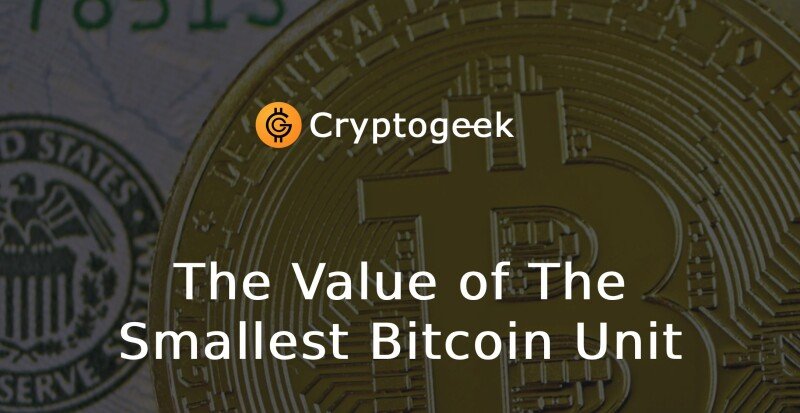1 Satoshi to USD: What Is the Value of the Smallest Bitcoin Unit?


What is 1 satoshi to USD? When you're just beginning to learn about Bitcoin, you would be surprised to learn that the cryptocurrency has the potential to be divided in very tiny units called satoshis. The micro-units enable the possibility of using Bitcoin in daily expenditure, no matter the amount being tiny. In this article, we shall dig deep into the conversion 1 satoshi to USD, the importance of satoshis, and the role they play in the bigger realm of digital currency.
Contents
- What Is a Satoshi?
- Convert 1 Satoshi to US Dollars
- Why Satoshis Matter
- A Brief History of Satoshis
- Satoshis as Used Daily
- What Tracks the Value of 1 Satoshi to USD?
- Price Movement and Volatility
- Influence of Lightning Network and Microtransactions
- Satoshis' Future in the Global Economy
- Conclusion
- FAQ
What Is a Satoshi?
The smallest unit in the cryptocurrency Bitcoin is the satoshi. 1 Bitcoin has 100,000,000 satoshis. Hence, 1 satoshi = 0.00000001 BTC.
The word “satoshi” is in honor of Satoshi Nakamoto, the mysterious creator (or group of creators) of the virtual currency, Bitcoin. As cents to the dollar or pence to the pound, satoshis are one way to fractionalize the currency of Bitcoins in more convenient divisions.

As the value of one Bitcoin coin has crossed thousands of dollars, the satoshi has obtained even more purpose for minute transactions, microtransactions, and general use.
Convert 1 Satoshi to US Dollars
So how many USD is 1 satoshi worth in real terms? The value of 1 satoshi is dependent on the value of 1 Bitcoin. If the value of 1 Bitcoin is $50,000, then:
1 satoshi = 0.00000001 BTC = $0.0005
As the value of Bitcoin fluctuates, the value of one satoshi also fluctuates. You can always determine it with the following easy formula:
1 satoshi = Price of Bitcoin in USD * 0.00000001
This also applies in reverse. If 1 satoshi is $0.0005, then the value of the Bitcoin is $50,000.
Why Satoshis Matter
Satoshis make Bitcoin’s usage in daily life more sensible. Consider the hassle in paying for one $3 cup of coffee in Bitcoins. At $50,000 per coin for BTC, you would be sending 0.00006 BTC, cumbersome to read and use. It’s more convenient to quote the 6,000 satoshis.
As the value and popularity of Bitcoin grow, mentioning satoshis will be the de facto means to talk about amounts. Already some wallets and applications even offer the option to switch your display from BTC to sats (satoshis) to enable easier comprehension.
A Brief History of Satoshis
Satoshis were part of the planning for Bitcoin from its outset. The smallest unit in the initial version of the Bitcoin protocol was set by Satoshi Nakamoto as 0.00000001 BTC and has never been adjusted.
Though the term "satoshi" did not acquire popularity in the initial phase, it slowly became the de facto term for the micro-unit. The Bitcoin community had already begun to use the term by 2011. It even obtained some more boost when Bitfinex and BlueWallet started to utilize satoshis in the user interface.
In more recent times, there’s even been an initiative within the crypto space to quote prices in satoshis rather than full BTC in the hopes of making the price of Bitcoin more accessible.
Satoshis as Used Daily
The concept of transacting in satoshis is now more than theory. Payment applications like Strike, Cash App, and Wallet of Satoshi allow you to send and receive satoshis over the Lightning Network - high-speed, low-fee layer on the Bitcoin network.
For example, one podcast network would allow its subscribers to send 100 sats worth of tips to creators. That’s less than one-half cent, but it matters and allows the micro-payment to flow smoothly around the globe.
Bitcoin machines, exchange websites, and even some shops now display the prices in satoshis for the convenience of the users.
What Tracks the Value of 1 Satoshi to USD?
Different websites and platforms track the value of satoshi in real time. Some of the most used ones include:
- CoinMarket
- CoinGecko
- BitcoinPrice
- Sats
These websites allow individuals to change BTC, satoshis, and USD in real time. Some even include features such as price alerts and history graphs, showing how the value of 1 satoshi in terms of the US Dollar has fluctuated over time.
Apps for wallets and Lightning services also usually show figures in both satoshis and fiat currency to keep users updated without them having to do calculations manually.
Price Movement and Volatility
Since satoshis are attached to the value of the price for Bitcoin, they’re equally volatile. When Bitcoin loses 10%, satoshis also lose 10% of the value in dollars. The tiny unit size doesn’t insulate you from price fluctuations in the market.
However, satoshis come in handy for long-term thinkers. Most of the die-hard Bitcoin believers save satoshis over time by employing the strategy of stacking sats- purchasing them in small quantities over time in order to save over a long period.
Whether Bitcoin is going up or down, stacking sats helps people focus on accumulation rather than daily price movements.
Influence of Lightning Network and Microtransactions
The Lightning Network has made the satoshis shine. It allows people to send even tiny amounts of 10 or 50 sats literally in seconds and nearly for free.
It would pave the way to the following:
- Tipping authors of online content
- Payments per second/minute for streaming of multimedia content
- Splitting the bill to the cent
Platforms like Fountain.fm, Zebedee, and Alby are experimenting with microtransactions in sats. What they show is Bitcoins don’t necessarily have to be saved for the big reserves but can be utilized for the small items as well.
Satoshis' Future in the Global Economy
As more people come to use and trust Bitcoin, satoshis will likely be part of everyday financial speech. Already, some proponents of the currency hope to see the terms for the price of the currency disappear in favor of sats. Instead of saying “Bitcoin is $30,000,” we might one day say “1 BTC = 3,000,000,000 sats.”
While this has not yet materialized, it shows how seriously people are getting about the idea of using Bitcoin as everyday currency. The more people use Lightning wallets and accept Bitcoin for goods and services, using denominations in sats may be the next logical step.
Conclusion
What's 1 satoshi in terms of USD, you wonder? It's a cent's fraction, yes, but its part in the future of currency is by no means negligible. Satoshis make the use of Bitcoin easier, more understandable, and more practical in daily life.
They represent the shift in how we think about money. Instead of awkward decimals such as 0.000043 BTC, we can talk in integer figures like 4,300 sats. And that matters if Bitcoin is ever to mainstream.
Whether you're earning sats for savings, spending them for purchases, or just inquiring, understanding the value they hold is the key to the world of digital currency.
FAQ
What is 1 satoshi in terms of USD?
The value changes with the price of Bitcoin. At $40,000 for Bitcoin, 1 satoshi costs $0.0004. Utilize the satoshi-to-USD conversion calculators for real-time conversion.
Yes, 1 satoshi can be bought.
Technically, yes. There is usually a minimum purchasing requirement at most exchanges, but on services like Lightning-enabled wallets, you can send and receive as little as 1 satoshi.
Why one unit has the name satoshi?
It’s dedicated to Satoshi Nakamoto, the mysterious creator of Bitcoin. The unit was added to the coding of Bitcoin during its creation.
How many satoshis contain 1 Bitcoin?
1 BTC contains 100,000,000 satoshis. It’s the smallest unit of BTC in existence.
Yes, you can transmit satoshis using ordinary bitcoin wallets.
Yes. All wallets allow you to send BTC in any amount, including satoshis. Some apps even show your balance in sats for convenience reasons.
What does “stacking sats” mean?
It means to consistently buy and save amounts of Bitcoin in satoshis, just like dollar-cost averaging in the field of conventional investing.
Are satoshis used in daily transactions?
Yes. The Lightning Network services allow you to send and receive satoshis for services like tips, streaming content, or virtual goods.
This is for posting on https://cryptogeek.info/, to educate readers on the value and utility of satoshis in the growing Bitcoin economy.







Here are no comments yet. Be the first!